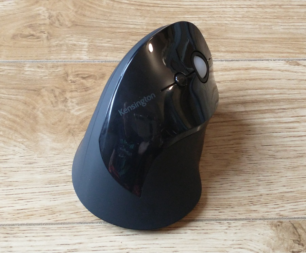
You need a new mouse to use with your laptop or desktop but you’re not sure what you’re looking for. I’ve been in that situation, and it’s tough. How can you really figure out you needs without comparing the different types of mice? So that’s why I was excited to have the chance to compare four different mice from Kensington—Pro Fit Ergo, Orbit Wireless, SlimBlade Pro, and Pro Fit Ergo TB550.
Here’s a look at all 4 of these mice from Kensington, the features they offer, and the situations that they would work best in.
Kensington Pro Fit Ergo vertical wireless mouse

The defining feature for the Kensington Pro Fit Ergo vertical mouse is ergonomic comfort. Your standard mouse requires your hand and wrist to be in a position that can cause physical issues. By re-orienting the mouse so that your hand is in a neutral position, it reduces that physical stress. Your hand stays in a “handshake” position while you use the mouse. And it has an extended lip to support your pinky finger. You’ll find this the best option for replacing your old standard mouse without having to adapt to new gestures.
| Power source | AAA battery |
| DPI Options | 800/1000/1200/1600 |
| Connectivity | 2.4Ghz RF wireless |
Kensington Orbit Wireless trackball with scroll ring

This Kensington Orbit Wireless trackball mouse includes a scroll ring surrounding the trackball itself. So, instead of the standard vertical scroll wheel, you use the circular ring to scroll up and down the screen. I found the ring easy to use, and the mouse generally was functional and comfortable.
I especially appreciated the included wrist rest that you can choose to attach to the mouse. This mouse is great for someone with some experience in using a trackball, and is looking for added ergonomic support. It is also ambidextrous—easy to use for left or right handed people.
| Power source | AAA battery |
| DPI Options | 400/800/1200/1600 |
| Connectivity | Bluetooth/2.4Ghz RF |
Kensington SlimBlade Pro trackball mouse

This Kensington SlimBlade Pro trackball mouse has the largest trackball of the group, which makes it the trackball mouse easiest to use. And instead of having a dedicated scroll button or wheel, you twist the trackball to scroll. That motion took me a bit to learn.
This is an ambidextrous mouse, so you can use either hand to control it. The very low profile of the SlimBlade Pro increases its ergonomic comfort.
| Power source | Rechargeable internal battery |
| DPI Options | 400/800/1200/1600 |
| Connectivity | Bluetooth LE/2.4Ghz RF/wired |
Kensington Pro Fit Ergo TB550 trackball mouse

You’ve been hoping for a trackball mouse, but one that has the standard mouse form factor. I have good news if this is your very particular dream. The Kensington Pro Fit Ergo TB550 trackball mouse is the combination mouse of your dreams. It is a regular mouse form factor with a trackball on the side. And it is designed to prioritize ergonomic comfort.
I had a little bit of trouble adjusting to using a trackball exclusively with my thumb, due to my general clumsy imprecision. But using the mouse was very physically comfortable and I acclimatized to the trackball after a bit of use. This is a good mouse for a restricted workspace being used by someone who needs ergonomic comfort.
| Power source | Rechargeable internal battery |
| DPI Options | 400/800/1200/1600 |
| Connectivity | Bluetooth LE/2.4Ghz RF |
What is a trackball mouse?
If you haven’t heard of a trackball mouse before, you’re probably wondering what it is and if there is any benefit to using one instead of a standard mouse.
A standard mouse uses optical sensors to record changes in the mouse’s position as you move it, and moves the onscreen cursor to match. On the other hand, a trackball mouse uses the movement of the trackball itself. So a trackball mouse stays stationary and doesn’t need to be moved around. Such mice are well suited for situations where you have limited desk space.
Standard mice are much more prevalent, so there’s no learning curve to using a new one. A new Kensington trackball mouse will take some getting used to but it needs much less movement from your hand and wrist, which reduces potential physical strain.
Kensington’s ergonomic mouse design
Any task is a lot harder to do if you are in physical discomfort. The goal of ergonomic design is to reduce the potential for physical strain and injury. For a computer mouse, that means reducing the amount of hand and wrist movement, and preventing strenuous wrist and hand positioning. Each of the Kensington mice in this review takes a different approach to addressing ergonomic needs.
Kensington mouse configuration and customization
Your Kensington mouse can be customized using the KensingtonWorks software, which allows you to set preferences for various button assignments and features of the Kensington mice. You can even assign buttons to control your PC’s volume or other commonly used functions.
Adjustable motion sensitivity (DPI)
How do know how fast a mouse is? Well, it’s measured by the number of dots per inch (DPI). The higher the DPI is, the faster the mouse will move the cursor across your screen. But don’t mistake a high DPI as the best speed for every situation. It’s great to have a high DPI for web browsing or working on a text document. Conversely, a high DPI will increase your inaccuracy when working on detailed work like digital image editing. All four of the reviewed Kensington mice have several DPI options that you can easily switch between according to your needs.
Mouse connectivity options
The right mouse for you will give you the connectivity options that you need for optimal productivity. There are 3 different methods of connecting a mouse to your computer or mobile device, which you will also find on the Kensington mice.
Wired connection
This is the default basic connection type for mice. A USB cable that connects to your PC’s USB port. The drawback of a wired connection is the added desk clutter of the USB cable, and the restriction of movement that comes from being tethered. The advantage to a wired connection is reliability. There’s almost no external interference that can disrupt a wired mouse connection.
Bluetooth wireless connection
You’re probably familiar with Bluetooth connectivity as a standard. Most of your devices have Bluetooth as an option. And that’s both the benefit and the drawback of Bluetooth. You can easily connect the mouse wirelessly to a variety of devices. But if you have several Bluetooth devices in the same area, there’s a chance of signal interference. And there can be very slight occasional delays in response rate. Most of the time you won’t notice these tiny pauses, but it can be aggravating during a tense gaming competition.
2.4GHz wireless frequency
This wireless method uses radio frequencies (RF) as its broadcast mechanism. Your cordless home phone, if you have such a thing still, uses the same technology. It’s a reliable wireless communication method and is well suited for environments crowded with Bluetooth devices. But keep in mind that most PCs don’t have RF capability built in, so you’ll need to use a USB RF receiver. Each of the Kensington wireless mice comes with the RF receiver, but that receiver will mean one less USB port available for use.
Final thoughts
Now that I’ve had a chance to compare 4 different mouse models from Kensington at the same time, I can understand how they each can fit in the right situation:
- The Kensington Pro Fit Ergo vertical mouse is incredibly comfortable and a real ergonomic improvement over the traditional mouse, which makes it an easy device to add to your workflow. I’ve never been a trackball user, but now I’m able to see how effective they can be.
- The Kensington SlimBlade Pro trackball mouse has a low profile and accurate motion tracking that’s great for digital content creators.
- The Kensington Orbit Wireless trackball mouse with its soft wrist rest gives an additional level of physical comfort while working, suitable for office users who need to stay healthy.
- The Kensington Pro Fit Ergo TB550 trackball mouse combines a familiar form factor with the functionality of a trackball, perfect for someone transitioning from standard to trackball mice for the first time.
Overall, all four of these mice offer improved ergonomic support, easy customization, and full mouse functionality. I also appreciated that Kensington has put considerable effort into reducing the packaging used, and utilized recyclable materials as much as possible. Find the right mouse for you at Best Buy.





